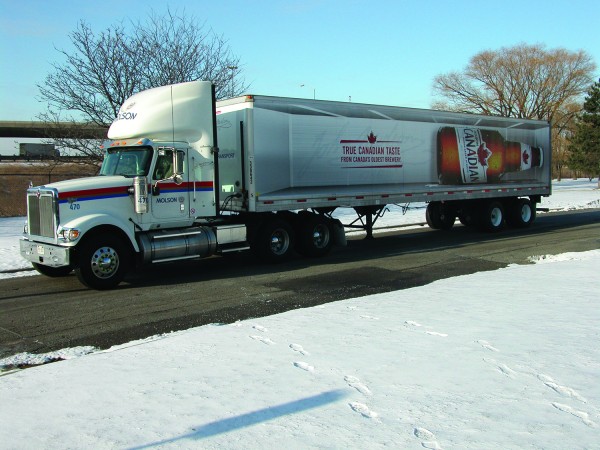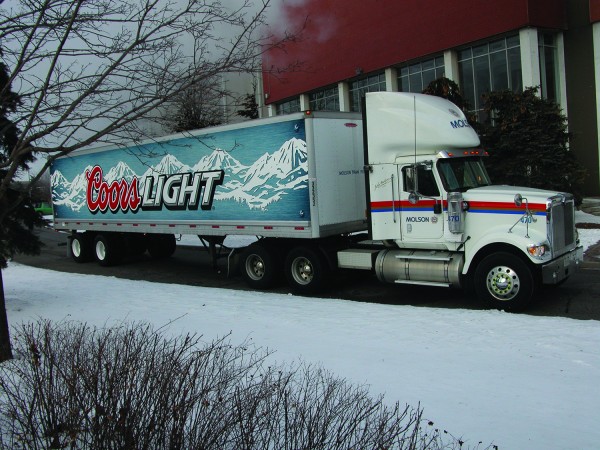Developing the ‘urban warrior’
Trucks are often blamed for traffic jams. Large cities need food, beverages and other products to be vibrant and alive in the downtown core. But long trucks designed for highway use are not ideal for inner-city use.
An example of a company that found a solution was Molson Coors. In 2005, when some councillors were suggesting restricting truck traffic in Toronto, Molson Coors asked for a truck-trailer design to properly get in and out of urban areas and deliver 60,000 lbs of payload. The trailers were designed in Toronto and have been running smoothly and efficiently throughout the local area ever since.
When people suggest throttling back truck traffic, which can reduce the supply of vital products efficiently flowing into large cities, it is worth noting that many companies are taking the initiative to find better ways to service an urban area. This is one example of many.
The truck trailer is 43-ft. long instead of 53-ft., meets Ontario’s Safe, Productive, Infrastructure Friendly (SPIF) regulations for heavy payloads of beverages, gets around tight city corners far better than common trailers and can get in and out of locations with minimal impact on local traffic.
To carry that weight and turn tight corners, a 3/8” thick coupler with a kingpin at 36 inches was used and the fifth wheel slid ahead to 24 inches. To avoid having the tractor rear frame rip out trailer cross-members on steep downhill ramp turns, the area behind the coupler was made higher than the coupler and without sharp points to catch.
That setting also forced the landing gear to be moved farther back, which triggered the need for an anti-nose dive safety leg at the front to avoid tipping when heavy pallets are forklift-loaded to the front wall. To save weight and provide good overhead clearance, the roof was lowered a foot which necessitated adding a catch to hold the roll-up door up high enough to avoid being clipped by a forklift mast. Small but important details to avoid downtime.
A 60-inch spread with a 14,000-lb front axle was used on the day cab tractor. An extra 2,000 lbs of payload would have been possible with a 72-inch spread but the 60-inch spread was better for sharp turns and payload was sufficient.
Andy Walker, Ontario distribution manager, Molson Coors, has a supply of 48-ft. vans and 53-ft. vans with quads for heavy long trips but finds that running a straightforward shorter tandem can have wider use than only for the downtown.
“We found that these trailers are not only efficient for the city but because they can safely carry a 60,000-lb payload, they can be used to service a wider area – even as far as Orillia. The 43-ft. has also been able to serve tight spots that previously required a B-train and the extra time to split and recouple,” Walker says.
Maneuvering around the city’s older areas can be brutal on equipment. Molson uses Ryder to keep equipment running smoothly. Brian Edwards, manager, technical sales support at Ryder System, adds some tips: “With the hard twisting, odd slopes, extra braking and frequent load/unload cycles, it is important to be rigorous on servicing and do frequent careful inspections of the complete unit.”
He adds “Custom units do not have a wide resale market so it makes good sense to work closely with the service provider to pick spec’s for a long term to get the best value on life-cycle cost.”
Many other companies have developed custom trucks and trailers to function smoothly in older downtown areas. In fact, most fleets who regularly service the downtown core have developed maneuverable designs and are not likely to have one of their units causing traffic problems.
However, there will still be cases where a dispatcher unfamiliar with a certain area will send in a driver with a 53-ft. trailer and a sleeper cab only to put the unfortunate driver into an awkward position for all involved. Some of those slips will continue to happen but it makes excellent business sense to be aware of the docks and areas where drivers are being sent and to use the right tool for the job. Everyone wins.
Looking towards the future, after improving traffic issues, there is now potential to make trucks even more urban-friendly by reducing noise, thanks to natural gas engine technologies.
“The refuse industry is taking advantage of using natural gas to lower fuel costs with the added benefit of dramatically lower noise levels (one-tenth of a diesel). It is a pleasant surprise for residents who expect a truck to be noisy,” notes Jeff Campbell, director of marketing, Cummins Westport in Vancouver. “The ISX12 G, 12-litre natural gas engine is a good match for urban deliveries of up to 80,000 lbs GCVW.”
As the technology improves, innovative companies are finding more efficient ways to service the market. Awareness of business opportunities like this is a natural and efficient way to help the trucking industry serve urban areas.


Have your say
This is a moderated forum. Comments will no longer be published unless they are accompanied by a first and last name and a verifiable email address. (Today's Trucking will not publish or share the email address.) Profane language and content deemed to be libelous, racist, or threatening in nature will not be published under any circumstances.